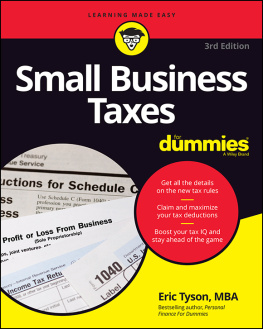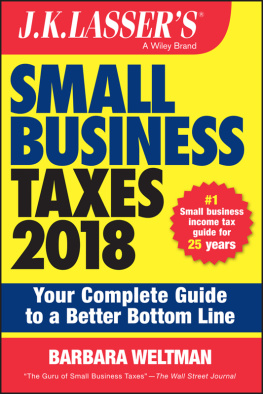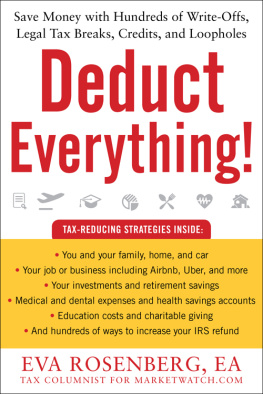Pay WAY Less Tax! 250+ Deductions, Credits & Tips from a Leading Tax Lawyer Proven Methods Guaranteed to Reduce Taxes. By Dale Barrett Copyright 2021 by Barrett Publishing. All rights reserved. No part of this book may be reproduced or transmitted in any form by any means graphic, electronic or mechanical without permission in writing from the publisher, except by a reviewer who may quote brief passages in their review. Any request for photocopying, recording, taping, or information storage and retrieval systems of any part of this book shall be directed in writing to Access Copyright, the Canadian Copyright Licensing Agency. To contact them call 1-800-893-5777 (extension 235) or go to their website, www.accesscopyright.ca, for more information. First edition 2021. Barrett, Dale 1974- Save Your Tax Dollars: 199 Tax Deductions, Credits and Strategies to save tax. ISBN: 978-0-9867559-9-6 Issued also in e-book format ISBN: 978-1-7775331-0-6 Dedication I dedicate this book to my three beautiful children Chlo, Claire and Joshua and my amazing wife Nicole, who have been patient with me even though I promised them that I wouldnt write a third book this year. I would also like to acknowledge the assistance of Simone Barrett, Darryl Getz, Jamie Elliot, and Simon Townsend all of whom made invaluable contributions to this work. Forward Dear Reader, This book is designed to help you pay as little tax as possible (legally). Hopefully this book saves you many more times its cover price. And if you borrowed this book from a library or a friend, you have gotten a great value (good for you, bad for me and the Canada Revenue Agency).
But what I truly wish for is that you take this book, which is an anthology of tax tips, advice, and helpful tidbits gathered over the last 12+ years of the practice of tax law and use it to its maximum potential to save yourself tremendous amounts of tax and avoid tremendous amounts of pain.
With all that said, well start the rest of the book with the first tip, that being: Canadian tax law changes regularly. CRA processes and procedures change. The most important thing that you can do to be able to pay as little tax as possible while staying on the right side of the law is to make sure that you re-examine your tax plan and the way you do things from time to time.
- Dale Barrett Legal Disclaimer As you read though this book please remember that its purpose is to provide you with information only. I have taken great care to ensure that the information is current at the date of writing, however things change, and mistakes do happen typographicallll and otherwise. So, the information presented herein should not independently be relied upon for any purpose and if you choose to use the tips herein they should be independently validated. Also, please do not consider the information in this book to be legal advice, regardless of having been written by a lawyer. It is not legal advice and reading this book does not constitute a lawyer client relationship between you and the author. If you think that you require legal advice, please do consult a tax lawyer, including the author. Table of Contents Part 1: Initial Concepts Future Value of Money The analysis of money and time is paramount in financial decision making. Time value of money concepts such as present value of money vs. future value of money are used to calculate and to compare the values of sums of money at different points in time. The time value of money refers to the fact that a dollar today is worth more than a dollar in the future (due to inflation). We all know this intuitively. What you can buy for one dollar today will cost you much more than a dollar in the distant future. Similarly, what you can buy for a dollar today would have cost much less than a dollar in the past. Consider the following example: Assume somebody owes you $100. You would rather get the $100 now than in 5 years time. This is intuitive to us all. On one hand, the $100 bill is worth $100 both now and in 5 years time. But because of inflation the $100 bill will buy you less in 5 years than you could buy now. Similarly, if you invest the $100 bill now, it will be worth more than $100 in 5 years time. The future value of a dollar is simply what the dollar, or any amount of money, will be worth if it earns interest for a specific time. So, if you got the $100 now rather than in 5 years, the future value of that $100 in 5 years will be more than $100. Tax Deferral (And Why It is a Good Thing) Tax deferral is a common tool used in tax planning. It refers to delaying paying tax into the future. Instead of paying the tax now, but paying the tax in the future, you can hold onto your money now, invest it and allow it to grow. Plus, you can pay the tax debt in the future with money which is worth less than today. As discussed earlier, due to inflation a $100 bill in the future is worth less (and has less buying power) than $100 now. So, if one has a tax debt of $100 it is better to pay it with $100 future dollars rather than $100 today dollars. In other words, it is better to defer the payment of the tax until the future. And if you can hold onto the $100 for a while and invest it until you have to pay it to the CRA, that is even better. With investment vehicles such as the Registered Education Savings Plan (RESP) and the Registered Retirement Savings Plan (RRSP), rather than paying tax now with today dollars, taxpayers can choose to pay tax on income in the future at a time when they are subject to a lower marginal tax rate. The RESP and RRSP are the most common vehicles for the average Canadian to benefit from tax deferral. With an RESP, a subscriber contributes income and in turn interest, dividends, and capital gains are earned within the RESP. When the money is finally withdrawn, it is taxed at the low marginal tax rate of a student enrolled in an eligible higher education program such as a university, college or trade school. An added benefit of an RESP is that the Canadian Government will include up to $7,200 as a no-strings-attached grant in an RESP. Up to $500 a year can be received as a grant depending on what the subscriber contributes into the account annually. An RRSP is another popular vehicle for Canadians to benefit from tax deferral. With an RRSP, taxpayers can deduct the amount that they invest from their tax returns. This means that no income tax is paid on the amounts invested. In turn, the investment can grow tax deferred inside the RRSP. Similar to an RESP and a Tax-Free Savings Account, there are massive financial benefits to tax sheltered compounding. Although tax is paid upon withdrawal from an RRSP, the taxpayer has control over when it is withdrawn. If a taxpayer retires at 65, and only has pension income (which places them in a lower marginal tax bracket than where they were pre-retirement), then they could save anywhere from 4-30% on each dollar withdrawn from the RRSP. This is notwithstanding that they have also benefited from earning tax sheltered income on a pre-tax investment. In a nutshell, an RRSP helps reduce taxes in several ways. Example: If a taxpayer is in a 50% tax bracket, they would pay $5,000 tax on $10,000 of income. But if they put that $10,000 into an RRSP, they will not pay the tax on that income right now. Instead, when they are retired and are in a 20% tax bracket (for example), they can withdraw this $10,000 and only pay $2,000 tax. Plus, they are paying $2,000 future dollars rather than $5,000 today dollars. Plus, they would have had the benefit of having the entire $10,000 invested inside the RRSP to earn income over the years giving them much more that they can withdraw in the future. |
|












